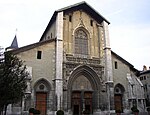Chambéry-Challes-les-Eaux station
Auvergne-Rhône-Alpes geography stubsBuildings and structures in ChambéryFrench railway station stubsRailway stations in France opened in 1856Railway stations in Savoie ... and 2 more
Railway stations served by EurostarTransport in Chambéry

Chambéry-Challes-les-Eaux station (French: Gare de Chambéry-Challes-les-Eaux) is a railway station in the Savoie département of France. The station serves the city of Chambéry. The station is served by three major high speed services, the TGV, Eurostar and Frecciarossa.
Excerpt from the Wikipedia article Chambéry-Challes-les-Eaux station (License: CC BY-SA 3.0, Authors, Images).Chambéry-Challes-les-Eaux station
Avenue de la Boisse, Chambéry
Geographical coordinates (GPS) Address Nearby Places Show on map
Geographical coordinates (GPS)
| Latitude | Longitude |
|---|---|
| N 45.571388888889 ° | E 5.9194444444444 ° |
Address
Avenue de la Boisse
73000 Chambéry
Auvergne-Rhône-Alpes, France
Open on Google Maps






